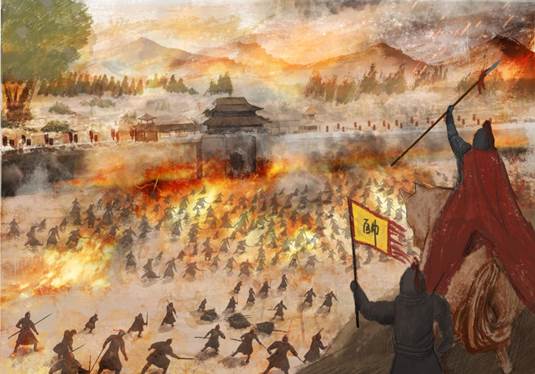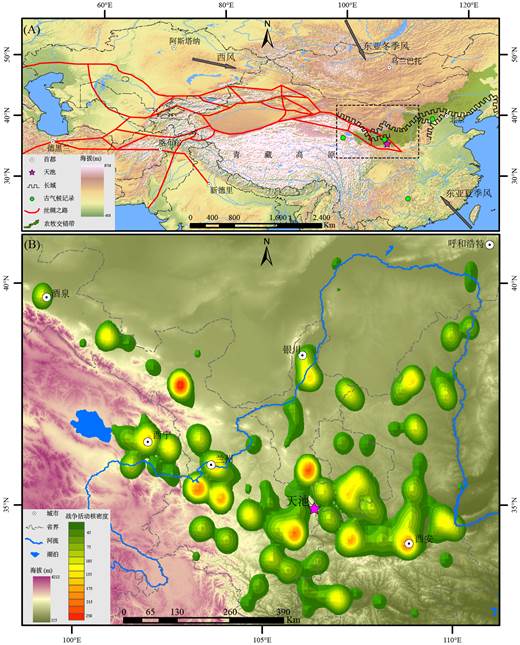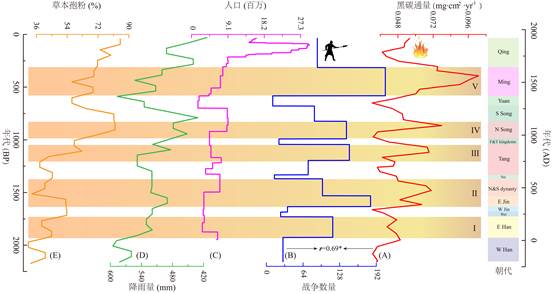Human activities are rapidly and profoundly affecting the Earth's environment, giving rise to the concept of the "Anthropocene," a forefront interdisciplinary scientific issue. Fire activities play a crucial role in global ecosystems, climate, carbon cycling, and human health. Consequently, there is considerable interest in understanding the historical impact of human activities on fire. Investigating when, at what spatial scales, and in what ways humans have influenced fire history is of significant value in addressing Anthropocene-related questions. While extensive research has revealed the promoting or inhibiting effects of human activities such as agriculture, pastoralism, and metallurgy on fire, the impact of war activities closely tied to human civilization development has not received sufficient attention, with limited reports in regions like Vietnam and Central America.

Figure 1: Typical scenes of fire activities triggered by wars in ancient China
China, as one of the earliest centers of civilization in the world, has a detailed historical record spanning thousands of years, documenting wars and fire incidents. Statistical data indicate that wars ranked first among known causes of fires in China's history over the past 2000 years, closely intertwined with the widespread use of fire in warfare (see Figure 1). The ancient military treatise "The Art of War" from the Spring and Autumn period explicitly documented the use of fire for military purposes. Wars involved various forms of fire attacks, including burning enemy camps, provisions, transport, arsenals, and vital facilities like transportation routes. Additionally, the consumption of firewood for heating and cooking during wars was substantial. Have these anthropogenic fires collectively intervened in the natural processes and patterns of wildfires? Currently, due to a lack of high-resolution ancient fire records and quantitative analyses of regional war activities, the relationship between the two has not been systematically revealed.

Figure 2: Overview of the Eastern Silk Road Region (A) and spatial distribution of war activities in the past 2000 years (B)
The Silk Road, a vital land route across the Eurasian continent during historical times (see Figure 2A), witnessed control disputes by various regimes due to its strategic significance. The Eastern Silk Road refers to the region along the line from Xi'an to Dunhuang, characterized by the interaction between northern agriculture and pastoralism and struggles among different nomadic groups for control over transportation routes. Consequently, this region became one of the most frequented areas of warfare in China over the past 2000 years, exemplified by the concentrated construction of the Great Wall (see Figure 2A). At the heart of the distribution of war activities lies a high-altitude lake, Tianchi of Liupan Mountain (also known as Chaona Jiao) (see Figure 2B), whose sediment provides a rare high-resolution record of ancient environmental changes. Thus, it is an ideal location for studying the historical relationship between war and fire.

Figure 3: Comparison of human activities with climate and vegetation changes over the past 2000 years
A team led by Professor Zhou Aifeng and Professor Dong Guanghui from Lanzhou University, in collaboration with researchers from the Lanzhou Institute of Arid Meteorology of the China Meteorological Administration and Nanjing Normal University, focused on Tianchi of Liupan Mountain. They conducted high-resolution black carbon tests on sediment using thermal optical analysis (TOR) to reconstruct the historical changes in fire in the region during the mid to late Holocene. Potential source contribution analysis (PSCF) of modern pollutants in the research area provided criteria for determining the likely sources of particulate matter. Scientific statistical analysis of war records in historical documents revealed the spatiotemporal variation of war activities in the region over the past two millennia. The results indicate that fire activity in the Eastern Silk Road region was not frequent during the mid-Holocene but increased significantly in the late Holocene, correlating with drier climate conditions and an increase in flammable herbaceous vegetation. However, since 2000 years ago, the intensity/frequency of ancient fire changes revealed by black carbon flux has significantly increased, seemingly decoupled from climate and vegetation changes. Instead, it synchronously changed with war activities on a centennial time scale (see Figure 3, A and B), indicating strong human intervention. The historical fire patterns controlled by climate for a long time were likely altered by wars between different political powers, aligning with the changes in Chinese dynasties, especially during the Eastern Han, Eastern Jin and Southern and Northern Dynasties, late Tang, Northern Song, and Ming periods (see Figure 3).
This interdisciplinary research comprehensively reveals the historical relationship between war and fire in the Eastern Silk Road region, elucidating the environmental effects caused by humans using fire as a means of warfare. It offers a new perspective and valuable research case for understanding how human activities exert significant influences on the Earth system and its history. The research, titled "Warfare Impact Overtakes climate-controlled fires in the Eastern Silk Roads since 2000 B.P.," has been published in the PNAS NEXUS journal, a sister journal of the Proceedings of the National Academy of Sciences (PNAS). Dr. Zhang Shanjia, a postdoctoral researcher, is the first author of the paper, and Professors Dong Guanghui and Zhou Aifeng from the College of Earth and Environmental Science at Lanzhou University are the corresponding authors. This work was supported by the National Natural Science Foundation of China, including the Outstanding Youth Project "Environmental Archaeology and Environmental Change" (41825001), the Major Project "Historical Background of the Anthropocene" (41991251), and the Chinese Academy of Sciences International Partnership Program (131C11KYSB20190035).
Link to the article:https://doi.org/10.1093/pnasnexus/pgad408